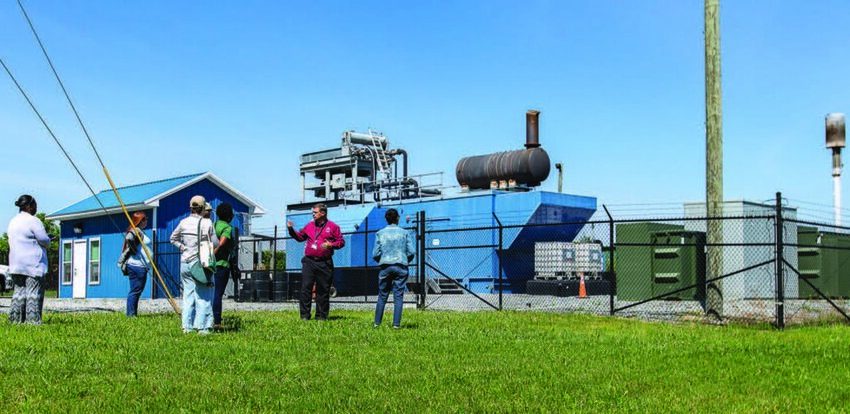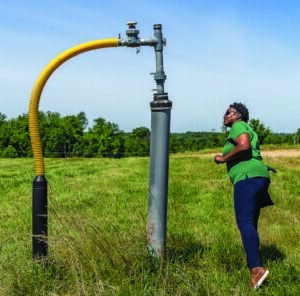 Richard Lovett, City of Greensboro Environmental Compliance and Support Manager, explains how the White Street Landfill methane gas to energy plant works to residents touring the site. Photo by Ivan Saul Cutler/Carolina Peacemaker.
Richard Lovett, City of Greensboro Environmental Compliance and Support Manager, explains how the White Street Landfill methane gas to energy plant works to residents touring the site. Photo by Ivan Saul Cutler/Carolina Peacemaker.While the debate continues regarding where to dispose of contaminated soil from east Greensboro’s Bingham Park, city officials recently provided guided tours of the White Street Landfill, one option where the soil may go.
 Resident and Greensboro Parks & Recreation Commission Chair, ChesKesha Cunningham-Dockery, inspects one of nearly 100 methane monitors in various locations at the White Street Landfill. Photo by Ivan Saul Cutler/Carolina Peacemaker.
Resident and Greensboro Parks & Recreation Commission Chair, ChesKesha Cunningham-Dockery, inspects one of nearly 100 methane monitors in various locations at the White Street Landfill. Photo by Ivan Saul Cutler/Carolina Peacemaker.Bingham Park was built on top of a household waste incinerator and an unlined landfill that operated between the 1920s and 1950s. Testing from the N.C. Department of Environmental Quality revealed that its soil contains arsenic, lead and iron. The park closed to the public in April 2024.
Residents living in the neighborhoods surrounding the White Street Landfill and those from Bingham Park have raised concerns about where the park soil will be placed to avoid further contamination.
Tiarra Brown, a member of the Bingham Park Environmental Justice group, participated in one of the landfill tours. Brown said that although White Street doesn’t operate like a traditional landfill, the environmental justice group does not support harming another community to fix theirs.
“It was interesting to see the city’s investment in renewable energy,” said Brown. “But it’s still a concern of safety for the community, and that’s what matters to me. I’m in full support of cleaning up Bingham Park, but not at the risk of harming other people. The city should listen to what the community is saying.”
The city is currently in the process of selecting from three proposed sites for soil disposal. The White Street Landfill, being the closest to the park, is the least expensive option with an estimated cost between $24-$27 million. The other two sites under consideration are the Great Oak Landfill in Asheboro and the Uwharrie Landfill in Troy.
Environmental Compliance and Support Manager Richard Lovett noted using the landfill to dispose of the contaminated soil could speed up its closure.
“The remaining life expectancy at this landfill, if nothing happens, is 2057. If Bingham Park’s waste is brought here, it cuts that by about eight and a half years,” said Lovett.
Since its closure in 2005, the city has equipped the landfill with an updated methane gas collection system, a stormwater runoff collection system and a solar farm.
The city estimates it could take about 11,500 trucks to remove more than a dozen acres of contaminated soil from Bingham Park. The soil will be deposited into Phase III of the landfill. City permits would also have to be modified to reflect the large amounts of new soil being accepted, which will be greater than what the landfill usually accepts on an annual basis.
City officials assert that the contaminated soil from the park, because it will be in a lined landfill and covered with clean soil daily, there is no risk of people being exposed to the contaminants, like in the park.
“It would be deposited, and every day there would be a daily cover, which is basically another type of soil that’s placed on top as per state requirements,” Lovett said, who added that the community’s concerns will be added to the city’s Remedial Action Work Plan.
During a June 4 meeting of the Greensboro City Council, some council members reiterated that they believe the White Street Landfill will be the safest option to dispose of the contaminated Bingham Park soil. Some residents disagreed saying convenience for the city may not be the safest for residents over time.
“Bingham Park’s issue has community input. I would ask anyone to tour the landfill. Do you even know what it looks like, what it smells like, what it doesn’t look like anymore?” said District 1 Councilmember Sharon Hightower.
“If there was any harm or any danger, I would say no.”
Greensboro Mayor Nancy Vaughan added that closing the White Street Landfill sooner is a plus for the community.
“That is a big plus to the people who live in that neighborhood. And it makes the duration of the project significantly shorter. Otherwise, they’re going to be a number of neighborhoods around Bingham Park that will have trucks going in and out of their neighborhood for over a year,” Vaughan said.
Mayor Pro Tem Yvonne Johnson said that her support lies with the community.
“There are a lot of people who are in opposition in the neighborhoods. I’ve talked to them, they’ve called me. One of the most passionate decisions that I’ve ever made was to close that landfill. And I made a promise to the people that I would not ever vote to open it, and I’m not,” said Johnson.
The City of Greensboro will host a community update meeting on Wednesday, June 12, at 6 p.m. at Peeler Recreation Center, 1300 Sykes Ave., to discuss the option of using the White Street Landfill to dispose of contaminated soil from Bingham Park.
Community members can request a tour of the White Street Landfill under the Greensboro Parks and Recreation Department on the city website at www.greensboro-nc.gov.